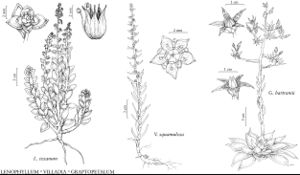Graptopetalum
Contr. U.S. Natl. Herb. 13: 296, fig. 55, plate 52. 1911 ,.
Herbs [or shrubs], perennial, not viviparous, 2.5–3.5 dm, glabrous or papillose. Stems erect, branched or unbranched, succulent; floral stems annual, axillary, overtopping rosette, with scattered smaller leaves. Leaves persistent, in dense, basal rosettes, alternate, sessile, subclasping [narrowed] basally; blade cuneate or rhombic-oblanceolate or obovate, laminar or semiterete, 2–10 cm, succulent, base not spurred, margins entire; with [1] several veins entering margins. Inflorescences lateral, flat or paniculate cymes. Pedicels present. Flowers (fetid), erect, 5–8-merous; sepals distinct, ± alike in size; petals spreading or slightly reflexed from middle, connate basally, [mostly] pale-yellow irregularly dotted and red-banded in distal 1/2; calyx and corolla not circumscissile in fruit; nectaries flabellate; stamens [as many] 2 times as many as sepals; filaments adnate to corolla base, (becoming reflexed); pistils erect, connate basally; ovary base narrowed; styles 2+ times shorter than ovaries. Fruits mostly erect. Seeds narrowly ovoid, finely grooved, papillose. x = 30–35.
Distribution
Ariz., Mexico
Discussion
Species 15 (2 in the flora).
From cytological studies (C. H. Uhl 1970, 1992), Graptopetalum belongs to a large comparium with Echeveria, Lenophyllum, Villadia, and others, but not including Dudleya.
Selected References
None.
Lower Taxa
Key
| 1 | Rosettes solitary or multiple, 7-16 cm diam.; leaf blades smooth, apex scarcely apiculate; flowering fall–winter; corollas 19-28 mm diam.; flowers mostly 5-merous; inflorescences paniculate cymes. | Graptopetalum bartramii |
| 1 | Rosettes densely cespitose, 2-6(-10) cm diam.; leaf blades rough, apex with slender apiculum 1-3 mm; flowering late spring; corollas 14-21 mm diam.; flowers 5-8-merous; inflores- cences mostly flat cymes. | Graptopetalum rusbyi |
